Chile’s diverse geography, with the Andes Mountains to the east, the Atacama Desert to the north, the Pacific Ocean to the west, the Patagonian Ice Fields to the south, and its wide-ranging climates and soil types, make it a land that is beneficial for viticulture. Transversal river valleys that run from east to west, from the Andes to the sea, allow the cool sea breezes to blow inland every evening, and Chile’s Mediterranean climate, with its warm, dry summers, and cold, rainy winters, is ideal for wine production.
Chile’s Mediterranean climate, with its warm, dry summers, and cold, rainy winters, is ideal for wine production. The interaction between the sea and the Andes Mountains has a positive effect on the growing season in the vineyards, which benefit from the sunny days and temperatures that drop dramatically each night, creating a broad daily temperature oscillation, which helps wine grapes develop fresh fruit flavors and good acidity. In the case of the red wines, it helps develop deep color in the grape skins and high levels of antioxidants and quality.















